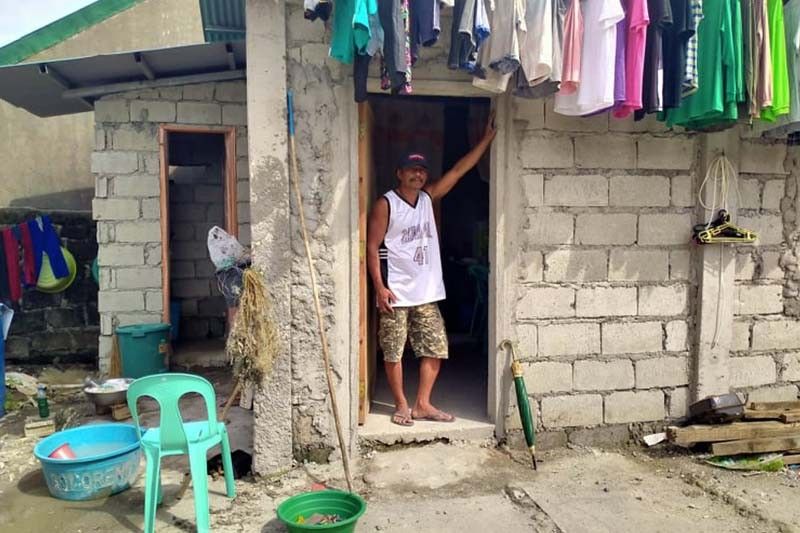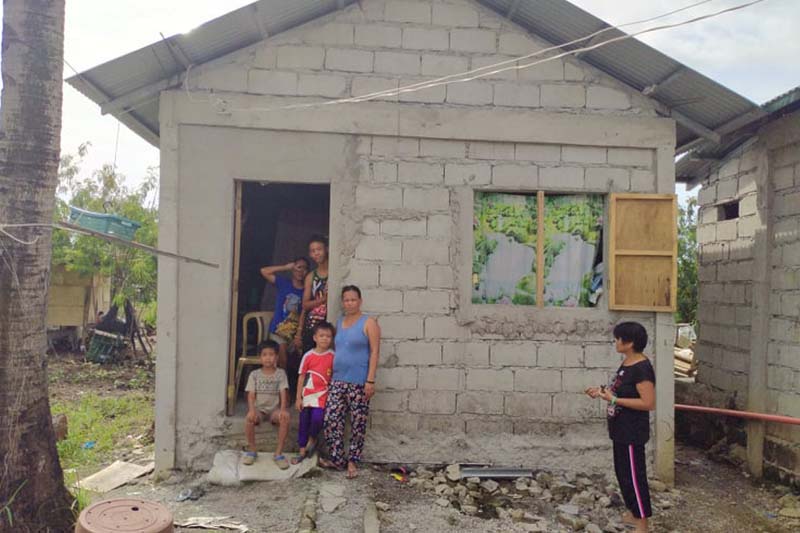For former Taliptip folk, houses of concrete and worry over how to eat

MANILA, Philippines — In late October, the last families from Sitio Kinse—one of the coastal villages in Barangay Taliptip in Bulakan, Bulacan—moved inland into their new houses made of concrete, marking the end of their long fight to hold on to their homes and their way of life.
The six households moved out of their decades-old homes off the coast of Bulacan—the site of the P740-billion Manila International Airport and its adjacent airport city—to a relocation site in Barangay Bambang on October 31, a day before Super Typhoon Rolly (Goni), the world’s strongest storm this year, lashed Luzon.
Their houses are now stronger and in a safer area. Their former homes used to stand on stilts, on a dry piece of land surrounded by patches of mangroves in Manila Bay.
But Sherly Bacon, one of the former residents of Sitio Kinse, said their lives have become more difficult.
“Back there, even though our houses were made from wood, we were able to make money to buy things. Here, we are incurring debts. In Taliptip, we never experienced running out of rice, we used to buy 20 kilograms of rice. Now, we can only afford to purchase a kilo at a time,” Sherly said in Filipino in a phone interview.
More spending, lower income
Unlike the residents who dismantled their homes early on, Sherly and the last families from Sitio Kinse fought for their right to be given a relocation site of their choice by project proponent San Miguel Corporation. They said they wanted a place where they were assured of their livelihood.
The men of their small community are still fishing in Manila Bay. They will do so until the construction of the sprawling airport city begins. But they are now making less as they are spending more money on gasoline for their boats to be able to fish and bring their catch to the local market.
Sherly, whose husband Teody is a fisherman, said fishers in their community are limited to fishing near where they used to live. In their case, Sitio Kinse. But here’s the problem: they're not catching much.
They used to earn by catching fish with their nets and setting up cages called “dragon bubu” to trap crabs, shrimps and smaller fish. Sherly said her husband could earn up to P5,000 a week back then. On luckier days, he could take home as much as P7,000 a week.
Teody ventures out to fish four to five times a week. If he doesn't catch much and if he has no money for gasoline, he stays home. Now, he only brings home around P2,000 a week for food and utilities.
“Sabi ko sa kanya, kung ganito lang sa isang linggo ang kita mo P2,000 ay mamamatay tayo sa gutom nito kung magpa-abot abot ang bayarin natin,” Sherly said.
(I told him that if he can only earn P2,000 a week, we will die of hunger because of the expenses.)
“Parang lalo ata kaming naghirap nung nakalipat kami dito,” she added.
(It seems our lives have become harder since we moved here.)
House woes
Each family was given cash assistance of P250,000 when they left Taliptip, Sherly said. They used the amount to pay for the land where their houses now stand and the materials needed to build them. San Miguel shouldered the cost of labor.
The community now has access to electricity, clean water and basic services. But Sherly lamented the quality of their houses is poor. She said walls have not been plastered and that the roof leaks.

“Tutal ginawa na nila ito sa amin, lubus-lubusin naman na nila ang tulong sa amin. Kung pwede sana ipabuo na nila itong bahay namin at mapalitadahan na namin na mula ang pera sa kanila kasi kung galing talaga sa amin ay hindi na [kaya],” she said.
(For me, since they have already made us leave, they can give us as much assistance as they can. I hope they can finish the house because we really don't have enough money for that.)
Putting food on the table
Food was never a problem for the community when they were living in Sitio Kinse, Sherly and other members of the community said in previous interviews. They, after all, relied on the sea for livelihood and food.
Villagers, including kids as young as seven, collected mud crabs and shrimps in mangroves just outside their former homes to earn enough money to take care of their weekly expenses and bring food on the table.
But thay cannot not do that now, making it a struggle to feed her family, Anita Anastacio, a mother of six, said.
“Maganda nga po [bahay namin]. Iwas baha. Kaya lang ang kapalit noon ay wala kaming pangkain,” Anita said, noting they could only cook rice twice a day.
(Our houses are nice, not flood prone. But the trade off is we have no money to buy food.)
Anita, just like Sherly, is unemployed and depends on her husband who earns a little from fishing. She has five children who are still studying—three are in high school and two are in elementary school.
“Nabubuang na ako kaiisip kung saan kukuha ng pang-gastos,” she said.
(I’m going crazy thinking where to source the money to cover our expenses.)
Anita is hoping she could sell cooked food for additional income. But, for now, the only thing she and her family can do is endure their current circumstance.
“Tiis lang talaga eh wala na kaming magagawa. ‘Yun ang buhay namin ngayon dito,” she said.
(We have to bear with it because there's nothing that we can do. That's our life now.)
Future beyond fishing
The residents do not know how much longer they can depend on the sea to provide. The bill granting San Miguel a franchise to build and run the new airport city is already up for President Rodrigo Duterte’s signature.
Once the bill is signed into law, construction can start anytime soon after needed permits are acquired. This means the waters that fed them and became their homes for decades will be filled with concrete.
In a release, San Miguel president and chief operating officer Ramon Ang said the airport project is the "single largest investment" in the Philippines by any company and is expected to generate hundreds of thousands of jobs in the construction phase alone.
The conglomerate is partnering with the Technical Education Skills and Development Authority to enroll former residents of Taliptip in skills-training courses such as welding, heavy equipment operations and cookery that would prepare them for jobs at the airport or start their own businesses. The first batch of scholars graduated recently, it added.
Sherly said she and her husband would try to avail of the livelihood courses.
“Ang hirap ng buhay dito pag wala ka talagang kita. Hindi pala talaga pwede dito na lalaki lang ang maghahanapbuhay kasi buwan buwan may bill kami ng kuryente’t tubig,” she said.
(Life is really hard here when you're not earning. It is not enough that only men earn because we have to pay for water and electricity every month.)
- Latest
- Trending





























